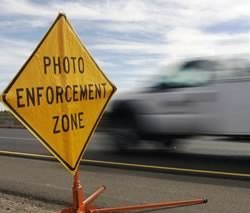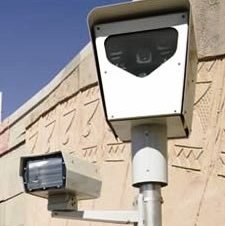A grass roots effort to ban photo radar enforcement in Arizona has failed to garner the signatures needed to make the statewide ballot this November. Yesterday was the deadline for turning in the signatures to the Arizona Secretary of State’s office.
Arizona was the first state to operate automated cameras on Interstate highways.
Arizona Citizens Against Photo Radar said during a press conference that the organization only gathered 120,000 voter signatures of the 153,365 signatures needed to qualify. The failure of the signature drive means that controversial photo radar will remain in local jurisdictions throughout the state. Proponents say that the cameras reduce crashes and save lives.
However, after fierce citizen opposition an automated-ticketing operation consisting of 78 fixed and mobile photo-enforcement units on interstate highways will cease operation after 15 July. An Australian company, Redflex, operates the revenue raising units for the state of Arizona. More than 1 million citations have been automatically generated since the state started installing the ticketing cameras a couple of years ago.
Headquartered in Arizona, Redflex has installed what is calls “public safety technologies” with automated cameras in 250 communities in 21 states.
A group called CameraFRAUD has just announced a $1.1M fundraising effort to continue the fight against all automated ticketing. The Chandler, AZ based organization calls itself the leading Arizona group advocating for the removal of all ticketing cameras.
CameraFRAUD was established in 2008 after then-Governor Janet Napolitano announced the creation of a statewide photo enforcement program, and it has held hundreds of events decrying what it says is warrantless government surveillance. The group also calls automated law enforcement “a rights-shredding profit machine.”
Napolitano wanted 100 cameras, saying it would generate $90 million in revenue a year. She claimed the program was designed to improve traffic safety, not make money.
Vandalism and violence ensued. In 2009, Thomas Patrick Destories was charged with first-degree murder in the shooting of Doug Georgianni, a Redflex technician who was in DPS-owned photo-enforcement vehicle.
A statistical analysis was conducted by the Arizona State University for the Arizona Department of Transportation (ADOT) and the Arizona Department of Public Safety (DPS) following the first ever “United States Freeway” program. When examining the crashes the study used non-peak hours, which amounted to approximately 18 hours per day on the weekdays and all day during the weekend.
It found that during the peak or “rush hour” periods, traffic was slowed below the posted speed limit due to congestion. The study claimed:
- The program reduced average speeds by approximately 9 mph.
- Total collisions were reduced by 44% to 54%.
- Total injury crashes were reduced by 28% to 48%.
- Single vehicle crashes were reduced by 59% to 63%.
- Sideswipe collisions were reduced by 33% to 48%.
- Rear end collisions ranged from a 14% increase down to a 23% decrease dependent upon which of the comparison models were used.


